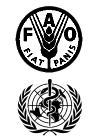
Codex Alimentarius Standards
Standards
In the years of its existence the Codex Members have developed a list of standards. Codex standards can be recognized by its prefix: CXS. They can be generally descriptive (e.g. General Standard For The Labelling Of Prepackaged Foods CXS 1-1985), give definitions for commodities (e.g. Standard For Mozzarella CXS 262-2006), contain food safety limit values (e.g. General Standard For Contaminants And Toxins In Food And Feed CXS 193-1995), and quality of the final product (e.g. Standard For Canned Salmon CXS 3-1981). With regard to these standards the Codex Alimentarius note that the Codex standards and related texts are voluntary in nature. They need to be translated into national legislation or regulations in order to be enforceable.
Next to the Standards the Codex Alimentarius does also develop Guidelines. Codex guidelines can be recognized by its prefix: CXG. They refer to a wide area of subjects, such as: nutrition, trade, chemical and microbiological analysis, and control. These guidelines contain recommendations and suggestions to help members in fullfilling the standards.
The third type of Codex texts refer to the Codes of Practice. Codes can be recognized by its prefix: CXC. These documents support producers with suggestions and recommendations, e.g. hygiene, storage and transport needs, how to avoid contamination. Most Codes are connected to Standards and Guidelines, and following a code will lead to foods that comply to the standards. It should be noted, that the codes are being developed to be directly usable for all Members, including less developed countries. Most suggestions are therefore practical of nature, and cost-effective.
The lists of standards, guidelines, and codes of practice are presented on the Codex website with their references (a ranking number and the year of origin), the title and responsible committee (this will be explained later), the year of the last modification, and a link to the actual text. The text can be available in six languages (being the defaults for the Codex Alimentarius). These languages are: English, French, Spanish, Arabic, Chinese, and Russian.
Databases
Some standards are known as MRLs. These are referring to pesticide residues and veterinary drug residues. These MRLs are included in searchable databases, where you can select the name of the chemical, classnames, and commodities to find the appropriate MRL. Besides the Codex refers to a database with maximum levels for additives, based on an implementation of the General Standard for Food Additives (GSFA, STAN 192-1995). The Maximum Levels (MLs) for contaminants and toxins in food are only available as a pdf document (GSCTFF, STAN 193-1995). That document was converted into a searchable database for this portal.
